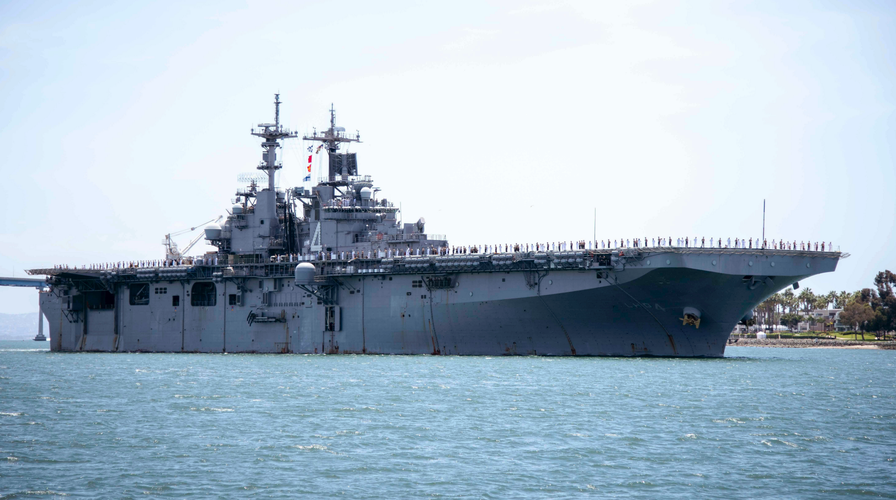Fox News Flash top headlines for January 4
Fox News Flash top headlines are here. Check out what's clicking on Foxnews.com.
A significant and potentially lesser recognized element of the Navy’s recently unveiled 30-year shipbuilding plan is its call for a full-scale "doubling" of its fleet of amphibious assault ships, a move that suggests the Navy expects ship-to-shore operations and major maritime attacks to figure prominently in coming years.
The plan stipulates that its fleet of amphibs will increase from 31 in 2022 to 62 by 2050, a huge force-size increase that likely pertains to the Navy’s plan to initiate a new class of smaller, faster and more agile amphibs. The text of the document says the plan "initiates the Light Amphibious Warship program in FY2022 and the Next Generation Logistic Ship program in FY2023 to support a more dispersed naval operating concept."
The Navy’s intentions likely incorporate a wide sphere of significant variables, such as the need for more dispersed, disaggregated operations, much larger numbers of drone boats and the arrival of fifth-generation airpower to amphibious warfare in the form of the F-35B. The Navy’s amphib plans incorporate an emphasis upon large-deck amphibs such as the emerging America-class by, among other things, providing funding to accelerate procurement of LHA 9, the fourth America-class ship. This push for big-deck or larger amphibs is equaled if not outmatched by plans for the Light Amphibious Warship program and the call for large numbers of unmanned ships.
Interestingly, many senior Navy weapons developers are fast evolving the concept of using big-deck ships as "motherships" able to perform command and control on large numbers of unmanned systems. Large manned ships could operate, coordinate and direct mission objectives for unmanned ships to execute. This would enable more dispersed amphibious assault possibilities as drone boats could conduct forward surveillance, test enemy defenses for points of entry, deliver major war assets such as armored vehicles to shore and even launch attacks when directed by humans.
NAVY ACCELERATES NEW SHIP RADAR TO SUPPORT EMERGING 'SEA-ATTACK' STRATEGY

File photo - In this May 1, 2019, photo provided by the U.S. Navy, the amphibious assault ship USS Boxer (LHD 4) transits the San Diego Bay in San Diego, Calif. President Donald Trump says the USS Boxer destroyed an Iranian drone in the Strait of Hormuz amid heightened tensions between the two countries. Trump says it's the latest "hostile" action by Iran. (Mass Communication Specialist 2nd Class Jesse Monford/U.S. Navy via AP)
The call for a massive influx of amphibs brings yet another substantial variable as well … the dawn of fifth-generation attack upon amphibious assault. A vertical takeoff-and-landing platform such as the Marine Corps F-35B, a platform already deployed on WASP-class and America-class amphibs, brings an entirely new dimension of stealthy close-air support and strike capability to an amphibious assault. As part of this equation, the F-35B is also capable of providing drone-like forward surveillance for attack commanders, while combining ISR with immediate attack possibilities.
CLICK HERE TO GET THE FOX NEWS APP
This dynamic might help explain why more future force warfare planners see amphibs as increasingly able to "project power" in forward, high-threat locations in almost a carrier-like manner. In fact, some have proposed that the Navy simply evolve its amphib fleet into a carrier-type mission role more fully, or at least strengthen that possibility alongside the other missions intended for amphibs.
-- Kris Osborn is the managing editor of Warrior Maven and the defense editor of The National Interest --
Kris Osborn is the defense editor for the National Interest. Osborn previously served at the Pentagon as a Highly Qualified Expert with the Office of the Assistant Secretary of the Army—Acquisition, Logistics & Technology. Osborn has also worked as an anchor and on-air military specialist at national TV networks. He has appeared as a guest military expert on Fox News, MSNBC, The Military Channel, and The History Channel. He also has a Masters Degree in Comparative Literature from Columbia University.





















